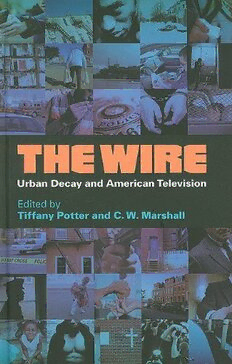
The Wire : urban decay and American television PDF
Preview The Wire : urban decay and American television
The Wire This page intentionally left blank The Wire Urban Decay and American Television edited by Tiff any Potter and C. W. Marshall 2009 Th e Continuum International Publishing Group Inc 80 Maiden Lane, New York, NY 10038 Th e Continuum International Publishing Group Ltd Th e Tower Building, 11 York Road, London SE1 7NX www.continuumbooks.com Copyright © 2009 by Tiff any Potter and C. W. Marshall All rights reserved. No part of this book may be reproduced, stored in a retrieval system, or transmitted, in any form or by any means, electronic, mechanical, photocopying, recording, or otherwise, without the written permission of the publishers. Library of Congress Cataloging-in-Publication Data A catalog record for this book is available from the Library of Congress ISBN: HB: 978-0-8264-2345-0 PB: 978-0-8264-3804-1 Typeset by Newgen Imaging Systems Pvt. Ltd. Chennai, India Printed in the United States of America Contents Acknowledgements ..........................................................................vii “I am the American Dream”: Modern Urban Tragedy and the Borders of Fiction C. W. Marshall and Tiff any Potter ................................................1 Baltimore before Th e Wire Afaa M. Weaver...........................................................................15 I. Baltimore and Its Institutions 1. Yesterday’s Tomorrow Today: Baltimore and the Promise of Reform David M. Alff ..................................................................................23 2. “We ain’t got no yard”: Crime, Development, and Urban Environment Peter Clandfi eld ..............................................................................37 3. Heroism, Institutions, and the Police Procedural Alasdair McMillan ......................................................................50 4. Th e Narrative Production of “Real Police” Ryan Brooks .................................................................................64 5. “I Got the Shotgun, You Got the Briefcase”: Lawyering and Ethics Lynne Viti ....................................................................................78 6. Posing Problems and Picking Fights: Critical Pedagogy and the Corner Boys Ralph Beliveau and Laura Bolf-Beliveau ...................................91 v vi CONTENTS II. On the Corner 7. Corner-Boy Masculinity: Intersections of Inner-City Manhood James Braxton Peterson ............................................................107 8. Stringer Bell’s Lament: Violence and Legitimacy in Contemporary Capitalism Jason Read .................................................................................122 9. Networks of Affi liation: Familialism and Anticorporatism in Black and White Stephen Lucasi ...........................................................................135 10. Barksdale Women: Crime, Empire, and the Production of Gender Courtney D. Marshall ...............................................................149 11. Aft er the Towers Fell: Bodie Broadus and the Space of Memory Elizabeth Bonjean .....................................................................162 III. Twenty-fi rst-Century Television 12. “Th e Dickensian Aspect”: Melodrama, Viewer Engagement, and the Socially Conscious Text Amanda Ann Klein ...................................................................177 13. It’s All Connected: Televisual Narrative Complexity Ted Nannicelli ............................................................................190 14. Dislocating America: Agnieszka Holland Directs “Moral Midgetry” Kevin McNeilly ..........................................................................203 15. “Gots to Get Got”: Social Justice and Audience Response to Omar Little Kathleen LeBesco .......................................................................217 Works Cited .....................................................................................233 Episode List .....................................................................................243 Notes on Contributors.....................................................................245 Index ................................................................................................247 Acknowledgements As with any edited volume, and particularly with a scholarly collection such as this, we have incurred many debts along the way. We are grateful to all our contributors, and to the people at Continuum for their assis- tance in bringing this project to fruition. We would like to thank for their assistance David Barker, Laura Hamilton, and Sam Tucker. We are also grateful to the University of British Columbia Hampton Fund and the Social Sciences and Humanities Research Council of Canada for funding research time. We are grateful to HBO for permission to use the cover images. Above all, we would like to acknowledge our great debt to Hallie Marshall and Ken Madden, for constant support, encouragement, insights, conversations, and (especially) for their tolerance of our obses- sion with television. Really, it’s incredible what they put up with. You have no idea. vii This page intentionally left blank “I am the American Dream”: Modern Urban Tragedy and the Borders of Fiction C. W. Marshall and Tiff any Potter “It’s kinda fun fi guring shit out.” —Prez (1.07) Requiem for Snot Boogie A cop and a drug dealer are sitting on a stoop in front of a boarded-up vacant, talking about the murdered man on the street before them. Th e opening dialogue of Th e Wire (1.01) encapsulates so many of the series’ tensions that it is worth spending a moment contemplating the fate of Snot Boogie. Street names are in some ways a cover, hiding who you are: for a while, Little Kevin’s physiologically inapt name keeps him safe from police (4.09). But they are also a badge, of honor or of shame. Th e cop, Jimmy McNulty, contemplates the body on the ground: “. . . his nose starts runnin’, and some asshole, instead of giving him a Kleenex, he calls him Snot. So he’s Snot forever. It doesn’t seem fair.” It isn’t fair, and the show implicates its viewers in that unfairness by drawing us into a position where we oft en think of characters only by their street names. Bodie, Stringer, Wee-Bey, and Snoop don’t have recognizable fi rst names for most viewers, and even if the names are known (Preston, 1
